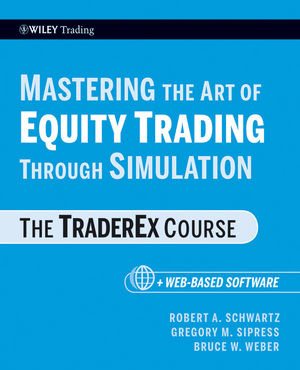|
Textbook
Mastering the Art of Equity Trading Through Simulation: The TraderEx Course, + Web-Based SoftwareISBN: 978-0-470-46485-4
Paperback
288 pages
July 2010, ©2010
 |
||||||
Preface.
How TraderEx Works.
Who This Book is For.
Overview of the Book.
Downloading the TraderEx Software.
How TraderEx Works with Micro Markets.
Acknowledgements.
Part One: An Overview of Equity Market Trading.
Chapter 1: Equity Market Trading.
The Costs of Trading.
Liquidity.
Market Structure.
Informational Efficiency (or the Lack Thereof).
Expectations.
The Players.
Summary.
Chapter 2: Simulation as a Learning Tool.
Canned versus Computer Generated Prices and Quotes.
Appendix: Intertemporal Returns Correlation.
Summary.
Chapter 3: How to Use TraderEx.
An Overview of the TraderEx Environment.
The Continuous Order Book Market.
The Dealer Market.
Call Auctions.
Block Trading Facility.
Crossing Network.
Hybrid Markets.
Summary.
Chapter 4: Introduction to the Trading Exercises.
The Buy-Side Perspective.
The Sell-Side Intermediary Perspective.
TraderEx Performance Measures.
Summary.
Part Two: TraderEx Exercises.
Chapter 5: Microeconomics Goes to Market.
Exercise 5.1: The Look of a Financial Market.
Exercise 5.2: What Are Your Attitudes Toward Risk?
Exercise 5.3: Call Market Trading.
Exercise 5.4: Trading Costs in Action.
Exercise 5.5: Dealer Costs and Inventory Control.
Exercise 5.6: Inter-Market Competition for a Stock Exchange.
Exercise 5.7: Finding an Equilibrium Value.
Exercise 5.8: Economic Effects of an Order Protection Rule.
Conclusion.
Chapter 6: The Order Book Market Structure.
Exercise 6.1: Entering Limit Orders.
Exercise 6.2: Entering Market Orders.
Exercise 6.3: Adjusting Limit Orders.
Exercise 6.4: Sizing your Orders – Markets and Limits.
Exercise 6.5: Post-Trade Analysis.
Exercise 6.6: A Really Big Order.
Exercise 6.8: Illiquidity.
Exercise 6.9: Heightened Volatility.
Exercise 6.10: News and Changing Expectations.
Exercise 6.11: Endogenous Expectations.
Exercise 6.12: A One-Year Holding Period.
Exercise 6.13: Crossing Networks.
Exercise 6.14: A Networked Simulation.
Conclusion.
Chapter 7: The Call Auction Market Structure.
The Price Setting Mechanism in TraderEx Call Auctions.
Exercise 7.1: Mechanics of the Opening Call Auction.
Exercise 7.2: Your TraderEx Call Auction Orders.
Exercise 7.3: Your Influence on TraderEx Call Auction Prices.
Exercise 7.4: Participating in the Opening Call Auction.
Exercise 7.5: Working a Large Order with Call Auctions.
Exercise 7.6: Proprietary Trading with Call Auction, and News Releases.
Exercise 7.7: Emphasizing Different Dimensions of Trading Performance.
Exercise 7.8: A Partially Disclosed Call Auction.
Conclusion.
Chapter 8: Dealer Markets: What Do the Trading Intermediaries Do?
Operations of Quote Driven Markets.
Exercise 8.1: Changing Quotes to Control Your Inventory.
Exercise 8.2: Market Maker Performance.
Exercise 8.3: Market Maker Risk Performance.
Exercise 8.4: Preferencing in Market Maker Systems.
Exercise 8.5: Volatility and Market Making.
Exercise 8.6: Low Liquidity and Market Making.
Exercise 8.7: Alternative Trading Systems and Market Making.
Conclusion.
Chapter 9: Dark Pools: How Undisclosed Liquidity Works.
Exercise 9.1: Mechanics of the Dark Pool.
Exercise 9.2: Seeking Advantages from Dark Pool Pricing.
Exercise 9.3: Working a Large Order with a Dark Pool.
Exercise 9.4: Proprietary Trading with Call Auction, and News Releases.
Exercise 9.5: Emphasizing Different Dimensions of Trading Performance.
Exercise 9.6: Dark Pools and Trade-Through Rules.
Conclusion.
About the Authors.
Index.



